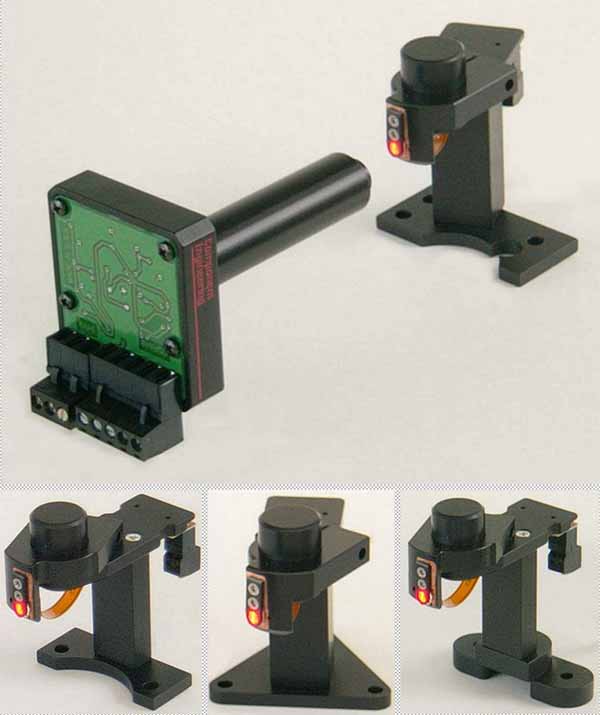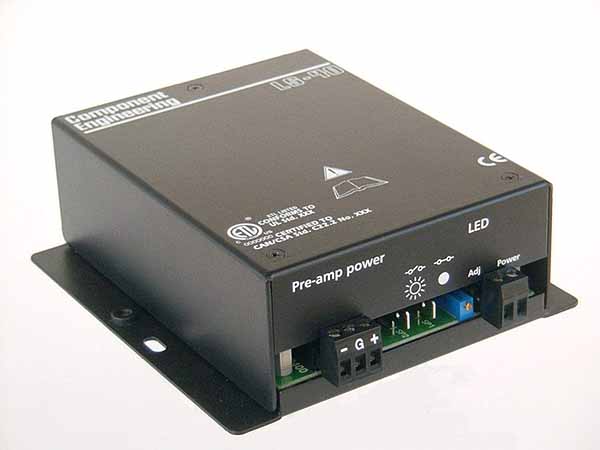|
|
This topic comprises 2 pages: 1 2
|
|
Author
|
Topic: New Analog Sound Readers
|
Bill Purdy
Expert Film Handler

Posts: 139
From: Seattle, WA
Registered: Oct 1999
|
 posted 07-28-2000 02:44 PM
posted 07-28-2000 02:44 PM





We are just starting production on a new line of low cost analog only sound readers for Simplex, Century, RCA and Ballantyne Model 7 sound heads. The idea is that if you have to change your heads to accomodate the cyan sound tracks, why not do it right and increase the quality of your sound at the same time?Therefore, we are offering these readers (called "ASR-40") which feature not only 660 nM red LEDs, but with geniune reverse scan and a nifty little low noise power supply. Pricing will depend upon your supplier, but in general they are a full 30% below our standard readers. This means that these kits are only slightly more than the cheaper solution, but you get so much more for your money. Small quantities will be available later in August. Should you want to know, all of our existing readers, analog and/or digital will still be available. For those of you going to ShowEast, please come by booth 1500/1501 and you can fondle them. What else would you like to know? 

------------------
Bill Purdy
Component Engineering
| IP: Logged
|
|
|
|
|
|
|
|
|
|
Bill Purdy
Expert Film Handler

Posts: 139
From: Seattle, WA
Registered: Oct 1999
|
 posted 07-29-2000 10:41 AM
posted 07-29-2000 10:41 AM





To answer Ken, Sorry about the Motiograph, and yes, you still have to exercise your sawzall in order to install one in a 1040. The reason is essentially the same for both of them and it is driven by the focal length of our standard lens. The lens focal length determines where the box containing the photocell has to be, and for these heads there is stuff in the way. The REAL reason is basic Economics 101. Volume buying saves a lot of money. We buy a lot of these lenses, enough that we can have them made to our wishes. While this is good, it means that we cannot afford to have more than one type in stock (we actually have two, but the other ones won't help in these cases). We recently had some samples made for a future issue, and they were 15 times the cost of our standard parts. So, with the Motiograph, one would have to remove that whole exciter lamp/lens bracket assembly which you can't do without removing the picture head, sawing chunks of the bracket out of the way and re-assembling with the reader head in place. The LED end would not be a problem. You can get the reader head into the RCA, but, yes, you still have to carve out that little vent baffle and remove the subassembly in order to get the lens and the adapter sleeve into the lens mount. At least you can do it without taking the whole projector apart.To Kevin, while we have managed to keep what we consider to be the factors important for a quality component, we have been able to save a lot of money in several areas. The power supply is an example. It is not a plug-in system which means no extra mounting package (but all of the connectors on the new one are unpluggable). Because we abandoned the requirement that it fit into a 1U rack space we could use off-the-shelf trasformers instead of the expensive custom one in the standard unit. While the pre-amp circuitry in the reader head is the same (actually, slightly better), it is much less expensive to buld. There is only one layer of circuit board instead of two. There is no internal lateral adjustment. Because of the quality of the lenses mentioned above, we no longer have to set the exact magnification of each unit as is done on the standard model. We have studied this enough to know that the lens tolerances are good enough that we can press all the parts together and after a quick check it is ready to ship. This saves a lot of expensive labor. On the other hand, we kept all of the sturdy machined housings. We kept the plug-in connections for ease of servicing. We kept the solid copper LED mounts for the best heat transfer. These mounts are also fully adjustable so that you can maximize the optical alignment. These two factors alone can mean greatly increased LED life. Speaking of increasing LED life, the power supply has in it a thumpless On/Off circuit so that you can turn them off between shows. That's the sort of stuff. ------------------
Bill Purdy
Component Engineering
| IP: Logged
|
|
|
|
|
|
|
|
|
|
Josh Jones
Redhat
Posts: 1207
From: Plano, TX
Registered: Apr 2000
|
 posted 07-29-2000 11:20 PM
posted 07-29-2000 11:20 PM





I thought they were CCD's but not sureBTW does anyone have any Gaumont Kalee proj pix? never seen an operational one Josh ------------------
"where to they teach you to talk like this, in some Panema City wana hump-hump-bar? sell crazy someplace else. we're all stocked up here" As good as it gets
| IP: Logged
|
|
|
|
Bill Purdy
Expert Film Handler

Posts: 139
From: Seattle, WA
Registered: Oct 1999
|
 posted 07-30-2000 09:35 AM
posted 07-30-2000 09:35 AM





From what I am reading from some of the questions, there seems to be a lack of understanding of how this reverse scan system works. OK, for most of us who make these things, here's how. Dolby Laboratories has had made the two essential elements for this system, and we all buy them from Dolby. One is the 660 nanometer red LED which is now the light source for both the analog and the digital readers. The other component is the receiving cell. This is a variant on the silicon photovoltaic "split" cell now used in almost all sound heads. This one consists of a very different configuration whereby there are the two cells separated by a very narrow septum and with a slit mask deposited right on top of the cell surface. What happens is that the red LED illuminates the sound track and the lens images the track onto the face of the cell. It is literally projected onto the cell. Because the image is magnified (about 3.6 times) the effective slit width is very small. Because the masking takes place on the surface of the cell there is essentially no cross talk and this in turn is why the stereo decoding is so perfect. Because the LEDs are nowhere near as bright as an exciter lamp, a pre-amp is required and that is what is built into the box at the end of the lens tube. Its output emulates the signal that would be coming from one of the original open cells. This is why the new readers should interface with all of the other processors. This pre-amp requires bi-polar DC current which is generated by the power supply which also, of course, supplies the current to the LED. In the case of our power supplies, the output to the LED is current regulated and the no-load voltage is clamped to a safe level should the LED be connected backwards (the LEDs from Dolby may come with either polarity). I am sorry that the pictures may have given the impression that there is no sound drum....there most certainly must be. The pictures were taken to show only the parts of the kit. If you go to our website, "www.componentengineering.com" under Sound Reader you will see several pix with all the parts (including digital) in place. There is even a picture of at least the sound head portion of a Kalee. To Scott, the installation in a 1040 is slightly painful. The lens tube on the front of the pre-amp box is too long for it to be inserted into the slit lens clamp. The rear wall of the sound head is too close. Therefore, you have to remove that whole subassembly, stick the lens and its adapter sleeve in place and then put the assembly back in. Even then, when you try to focus it, the pre-amp box may want to be in the space occupied by that piece of cast iron in the upper left hand corner which is a light baffle over the ventilator slot. If you don't mind butchering the whole back end of the sound head you could just cut it away and both problems would be answered. ------------------
Bill Purdy
Component Engineering
| IP: Logged
|
|
|
|
|
|
|
|
All times are Central (GMT -6:00)
|
This topic comprises 2 pages: 1 2
|
Powered by Infopop Corporation
UBB.classicTM
6.3.1.2
The Film-Tech Forums are designed for various members related to the cinema industry to express their opinions, viewpoints and testimonials on various products, services and events based upon speculation, personal knowledge and factual information through use, therefore all views represented here allow no liability upon the publishers of this web site and the owners of said views assume no liability for any ill will resulting from these postings. The posts made here are for educational as well as entertainment purposes and as such anyone viewing this portion of the website must accept these views as statements of the author of that opinion
and agrees to release the authors from any and all liability.
|

 Home
Home
 Products
Products
 Store
Store
 Forum
Forum
 Warehouse
Warehouse
 Contact Us
Contact Us




 Printer-friendly view of this topic
Printer-friendly view of this topic



















